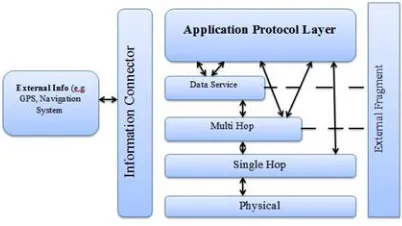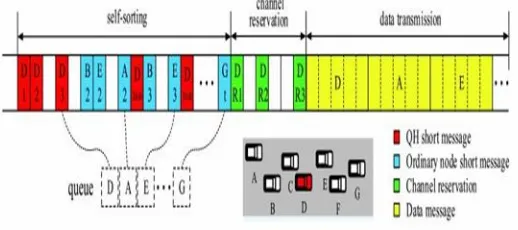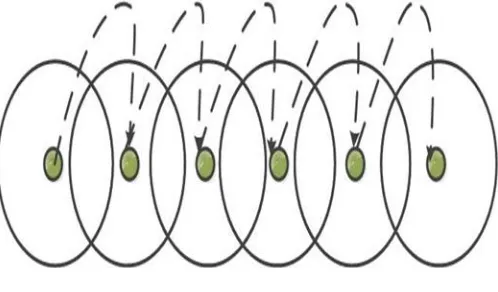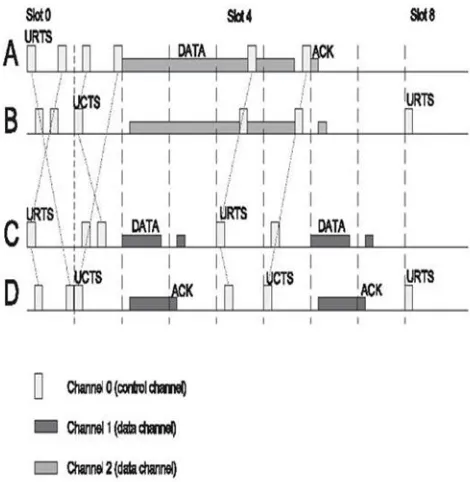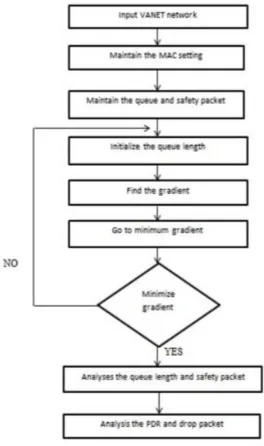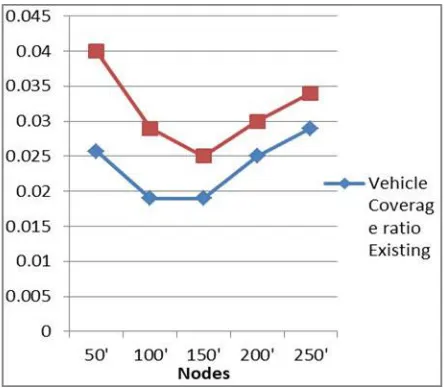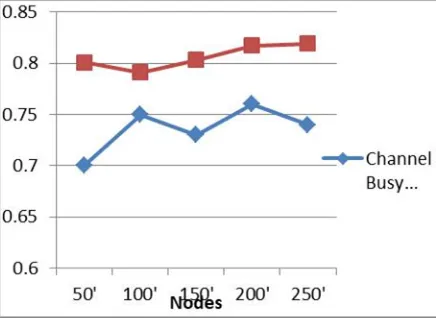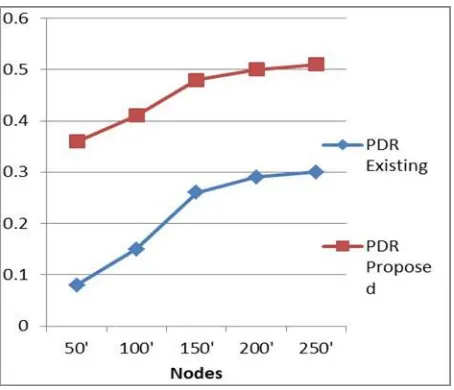IJIRMPS1806005 Website : www.ijirmps.org Email : editor@ijirmps.org 26
REDUCE THE CONGESTION IN CONTROL CHANNEL
OF MAC LAYER OF VANET USING MAC PROTOCOLS
1Abhishek Sharma, 2Rajeev Bedi, 3Dr. S.K Gupta
1M.Tech (CSE), 2Assistant Professor, 3Associate Professor
Department of Computer Science and Engineering, Beant College of Engineering & Technology, Gurdaspur
Abstract: Vehicular ad-hoc network plays an important role in road safety and congestion of traffic on the road. To provide the reliable and efficient communication during data transmission various methods and algorithms are used with this application. In this paper the author review on the MAC (Media Access control) protocol which supports the adaptive broadcasting mechanism. This protocol affects the critical parameters of the VANET communication.
Keywords: VANET, MAC, Vehicles RSU, TDMA, PDR
I. INTRODUCTION
VANET it stands for vehicular ad-hoc network. It is a special category of Mobile Ad-hoc Networks (MANET) which is consists of number of vehicles having ability to communicate with each other without any fix infrastructure. It is an important class because it is a key component of ITS (Intelligent Transportation system). IT’S helps to develop the infrastructure and communication among the vehicles and is a part of researches in smart cities. VANET is introduced under car to car communication and networking applications To provide safety, comfort and other road side services VANET co-exist with vehicle to vehicle and vehicle to roadside communication architecture. VANET is capable to communicate with other moving vehicles, fixed structure and road side unit (RSU) [1].
A. Architecture of VANET
The architecture of VANET is proposed by the number of the organization like IEEE, ISO, and European car industry (ECI) which varies from region to region. By using DSRC a unicast single hop communication is given by IEEE, where Continuous Air Interface for long to medium Range i.e. ( CALM) is given by ISO and ECI gives the Car to Car Consortium ( C2C-CC)which becomes the main driving force for vehicular Communication in 2007. This proposal gives its focus on the C2C-CC multi-hop and other W-LAN standards. The modes of communication of C2C-CC are unicast, broadcast, geo-cast and geo broad cast.
Figure 1.1: Architecture of VANET
Vehicular Ad hoc Network or VANET is a novel way to deal with intelligent transportation framework innovation which has gotten noteworthy consideration as of late. The model of the directing conventions utilized as a part of VANETs is exceptionally essential for upgrading the wellbeing of the drivers, managing movement and enhancing the entire driving background. VANET is a sort of mobile ad hoc networks
(MANETs). Different types of protocols are used to enhance the performance of the VANET. These protocols also support the TDMA and CSMA approaches. Different protocols like DMV, MAC are used to increase the delivery ratio and throughput of the network [2, 3].
B. MAC Protocols for VANET
IJIRMPS1806005 Website : www.ijirmps.org Email : editor@ijirmps.org 27 only in predetermined roads and they do not have the problem of resource limitation in terms of data storage and power. MAC protocols in VANET are mainly used to reduce the delay in information transfer.
MAC protocols for VANET
Figure 1.2: MAC Protocol Types
II. OVERVIEW OF VARIOUS MEDIUM
ACCESS CONTROL PROTOCOLS
A. Self-sorting Based MAC Protocol:
VANET a self-sorting based MAC protocol is introduced. There is also an introduction of access mechanism which helps in enhancement of self-sorting protocol for the purpose of appropriate time utilization to incorporate the mechanism. With the comparison of proposed protocol with self -sorting protocol and other network scenarios we investigate the performance of introduced protocol. The result shows that introduced protocol gives better performance in dense network and their performance in terms of output of the protocol
Vehicle in a collision-tolerance manner before data transmission. A logic queue is developed by vehicles automatically. In this paper a queue makes the self-sorting process in the MAC protocol.. The performance of the given protocol is determined by comparison process with other introduced protocols. The result shows that this introduced protocol has better utilization in high density [2].
Figure 1.3: Self Sorting Based MAC [2]
B. Hybrid TDMA/CSMA multichannel MAC:
Hybrid multichannel MAC protocol for the vehicular network. This protocol enhanced the throughput and reduces the collision on the network. The co-ordination between the nodes is nontrivial and it supports TDMA and CSMA to improve the reliability in broadcasting messages. This protocol controls the undesired messages and eliminates them. It works on the approach of time slot division and provides faster services [3]. The result of the proposed method shows that this method reduces collision level and enhanced the throughput of the network [4].
C. Directional Multi-channel MAC:
IJIRMPS1806005 Website : www.ijirmps.org Email : editor@ijirmps.org 28 network [5]. In this experiment MAC protocol is used for the channel coordination the proposed method is used to adjust the length between CCH and SCHs.
Contention free access of service channels (SCH). Traffic is optimized by using Markov model [6].
Dedicated multi-channel MAC protocol for vehicular network with adaptive broadcasting. This approach provides collision and delay free network when the traffic is increased. The simulation result of the proposed experiment shows the effective evaluation [7]. Clustering-based multichannel MAC protocol proposed for quality of service in VANET. In this approach clustering and contention free MAC are combined. Elected cluster head vehicle act as a coordinator to collect real time safety messages. It controls the channel assignments for cluster member vehicles in non-real time traffics [8].
Figure 1.4: Direction Multi-channels MAC
D. Connectivity aware MAC protocol
Shao, Caixing, et al. introduced the connectivity aware MAC protocol for Platoon-Based VANET. It analyzed the connectivity probabilities of vehicle-to-vehicle and vehicle-to-infrastructure. The relationship between the connectivity probability and system throughput is derived by using multi-priority Markov model. Length of the control channel is adjusted by using multichannel reservation approach [9].
E. Hybrid efficient and reliable MAC:
This protocol assigns the time slots to the moving vehicle in opposite direction to avoid the collision. It solves the exposed terminal problem and provides efficient and reliable data transmission. Parallel transmission of data provides the effective communication between the vehicles [10].
F. Coordinator based MAC protocol:
MAC protocol is used [10] for the channel coordination in vehicular ad-hoc network. In this network multiple channels are deployed that are service channel, control channel which enhance the safety on roads during traffic. The proposed method is used to adjust the length between CCH and SCHs. Multichannel coordination is used to provide the contention.
G. Multi-hop MAC protocol:
Cross layered MAC and clustering scheme introduced for efficient broadcast in VANET. Virtual backbones are created in vehicular network by using dynamic clustering algorithm. These backbones are responsible for the message propagation. In this fast multi-hop forwarding mechanism is used to exploit the role of backbone vehicles under cross layered approach [11].
IJIRMPS1806005 Website : www.ijirmps.org Email : editor@ijirmps.org 29 H. Secure MAC protocol:
MAC protocol is proposed for dedicated short range communication. This protocol is used to design a secure vehicular network for message transfer between the nodes on network. It provides a reliable communication with better latency rate [12].
I. Hybrid Multi Channel MAC:
MAC aware routing protocol for the wireless network in which next node decision is made on the basis of TDMA is proposed in this work. These decisions are based on the metrics delay, energy consumption, and hop number. The results of simulation show that this protocol provides high-density networks compared to the state of the art.
Figure 1.5: Hybrid Multichannel MAC
J. Adaptive TDMA based MAC:
Adaptive TDMA based approach is proposed which is based on the time division multiplexing access with Medium access protocol (MAC). This approach improves the performance of the VANET by handling the issues of dynamic topology change and high mobility in the vehicle modes [15].
K. PCF MAC Protocol:
Point Coordination function represents the MAC protocol is proposed in this work for energy saving by idle station by turning into the sleep condition and at this time active nodes exchange the data packets and improve the energy efficiency. The cycle analysis model is used to evaluate the energy efficiency in PCF and PGP protocol. The performance evaluation of the proposed work shows that it saves energy efficiently [16].
L. HE-MAC Protocol:
IJIRMPS1806005 Website : www.ijirmps.org Email : editor@ijirmps.org 30
Protocol Name Author Packet Throughput Delay Overhead
delivery Ratio
1. Self-sorting Based Ngo, Quynh et al √ √
MAC Protocol Shen, Zhongyi, et al.
2. Hybrid Nguyen, VanDung, et √ √
TDMA/CSMA al.
multichannel MAC
Kawakami, et al.
3. Directional Multi- Dang, DucNgoc √ √
channel MAC Minh, et al.
Wang, Qing, et al.
4. Connectivity Lu, Ning, et al. √
aware MAC Su, Hang, et al.
protocol
5. Hybrid efficient Duc Ngoc et al. √ √
and reliable MAC
6. Coordinator Sahoo, Jagruti, et al. √ √
based MAC
protocol
7. Multi-hop MAC Bononi, Luciano et al. √ √
protocol
8. Secure MAC Qian, Yi, et al. √ √
protocol
9. MAC Louail, Lemia, et al. √
10. Adaptive TDMA Cao, Shengbin et al. √ √
based MAC
11. PCF MAC Zheng, Guan, et al. √ √
Protocol
12. HE-MAC Protocol Ha, Taeyoung et al √ √
III. PROPOSED STUDY
This section describes the proposed work with the algorithm and flow chart of the methodology in detail. Here we describe the algorithm gradient descent which is used in VENET.
IJIRMPS1806005 Website : www.ijirmps.org Email : editor@ijirmps.org 31
Algorithm Used:
Input: Y, θ, X, α, tolerance, Max iteration Here, Y← Number of Queues θ← Queue length X← Vehicles
α← Variance in queue Length Output: θ
Step 1:
Current cost= Cost(Y,X, θ) {Current cost← Number of drop Packet}
If current cost < tolerance of variance then else
gradient = Gradient (Y,X, θ)
{Update the variance on the basis of variance change the queue length} Here α is learning rate.
IJIRMPS1806005 Website : www.ijirmps.org Email : editor@ijirmps.org 32 Step1: Input VANET Network.
Step2: Maintain the Media Access Control settings (MAC). Step3: Maintain the queue and safety packet.
Step4: Initialize the queue length.
Step5: Find the gradient descent on the basis of queue length. Step6: Select the minimum gradient among all.
Step7: Check the Gradient is minimum or not if yes the analyze is the length and safety packet otherwise initialize the queue length again.
Step8: Analyze the performance evaluation parameters Packet drop rate and Drop Packets
IV. RESULTS ANALYSIS
This segment gives a feature on presentation assessment procedure by the gained outcomes on diverse quantity of vehicles. The limitations for the presentation are also conversed in this section. The charts shown in the section signifies the enactment of the current and planned approach.
Parameters Used
The parameters used in this work represent the efficiency of the proposed work in the vehicular network. Following are the parameters that are used for analysis process in the next section:-
Vehicle Coverage Ratio: It is defined as the vehicles in the particular range. The generalize formula for this is following:
No. of Accident Occur: it is the ratio between the total packet transferred from a nodes and their delivery rate. If the packet delivery is successful then network is working properly if the nodes does not receive message due to failure is case of accident.
Channel Busy Ratio: This parameter defines the network ratio when the data packet delivered on the network is more than its efficiency and data transmission between vehicles goes slow.
Packet Delivery Ratio (PDR): It is defined as the ratio of total number of packets delivered successfully and the total number of packets sent from source to destination. Higher PDR signifies more efficiency in the network.
IJIRMPS1806005 Website : www.ijirmps.org Email : editor@ijirmps.org 33 In the above given figure 1.2 vehicle coverage ratio in existing and proposed approach is shown graphically. The X-axis shows the number of nodes and Y-axis represents the values of the Approach. The coverage of vehicles in the proposed approach is maximum then existing approach which shows the better network coverage in VANET.
Figure 1.3: Number of Accidents in Existing and Proposed Approach
In the above given figure 1.3 accident occur in existing and proposed approach is shown graphically. The X-axis shows the number of nodes and Y-axis represents the values of the approaches. The red line depicts the value of proposed approach and blue line depicts the value of existing approach. The accidents occur in the existing approach is maximum then proposed approach which shows the better efficiency of network in VANET. The least number of accidents shows the effectiveness of the VANET.
Figure 1.4: Channel Busy Ratio in Existing and Proposed Approach
In the above given figure 1.4 Channel Busy Ratio in existing and proposed approach is shown graphically. The X-axis shows the number of nodes and Y-axis represents the values of the approaches. The red line depicts the value of proposed approach and blue line depicts the value of existing approach. The Channel Busy Ratio in the proposed approach is maximum approaches. The red line depicts the value of proposed approach and blue line depicts the value of existing
IJIRMPS1806005 Website : www.ijirmps.org Email : editor@ijirmps.org 34 Figure 1.5: Packet Deliveries Ratio in Existing and Proposed Approach
In the above given figure 1.5 Channel Busy Ratio in existing and proposed approach is shown graphically. The X-axis shows the number of nodes and Y-axis represents the values of the approaches. The red line depicts the value of proposed approach and blue line depicts the value of existing approach. The Packet Delivery Ratio in the proposed approach is maximum and low in approach existing which shows the better efficiency of network in VANET. The Packet Delivery ratio shows the communication process in the network which is maximum at proposed approach.
V. CONCLUSION
In this paper gradient descent procedure is used for the improved queue properties. The network is struggled by the queue heads and each queue is based on the network based TDMA methodology. During earmarked slot of a queue grasps for service submission are also communicated by the queue associates. The performance appraisal of this work is done by improving the packet transfer percentage.
REFERENCES
F. Ngo, Quynh Tu, and Duc Ngoc Minh Dang. "Enhanced Self-sorting Based MAC Protocol for Vehicular Ad-Hoc Networks."
International Conference on AdvancedEngineering Theory and Applications. Springer, Cham, 2017.
[2] Shen, Zhongyi, et al. "Self-Sorting Based MAC Protocol for High-Density Vehicular Ad Hoc Networks." IEEEAccess(2017).
[3] Nguyen, VanDung, et al. "An efficient time slot acquisition on the hybrid TDMA/CSMA multichannel MAC in VANETs."
IEEE Communications Letters 20.5 (2016): 970-973.
[4] Kawakami, Tomotaka, and Koji Kamakura. "Modified TDMA-based MAC protocol for vehicular ad hoc networks." Pervasive Computing and Communication Workshops (PerCom Workshops), 2015 IEEE International Conference on. IEEE, 2015.
[5] Dang, Duc Ngoc Minh, et al. "Directional Multi-channel MAC for VANETs." International Conference on Advanced Engineering Theory and Applications. Springer, Cham, 2016.
[6]Wang, Qing, et al. "An IEEE 802.11 p-based multichannel MAC scheme with channel coordination for vehicular ad hoc networks." IEEE Transactions on Intelligent TransportationSystems 13.2 (2012): 449-458.
[7]Lu, Ning, et al. "A dedicated multi-channel MAC protocol design for VANET with adaptive broadcasting." Wireless Communications and Networking Conference (WCNC), 2010 IEEE. IEEE, 2010.
[8] Su, Hang, and Xi Zhang. "Clustering-based multichannel MAC protocols for QoS provisionings over vehicular ad hoc networks." IEEE Transactions on Vehicular Technology 56.6 (2007): 3309-3323.
[9]Shao, Caixing, et al. "Performance analysis of connectivity probability and connectivity-aware MAC protocol design for platoon-based VANETs." IEEE Transactions on VehicularTechnology 64.12 (2015): 5596-5609.
IJIRMPS1806005 Website : www.ijirmps.org Email : editor@ijirmps.org 35 [11] Sahoo, Jagruti, et al. "Congestion-controlled-coordinator-based MAC for safety-critical message transmission in VANETs."
IEEE transactions on intelligent transportationsystems 14.3 (2013): 1423-1437.
[12] Bononi, Luciano, and Marco Di Felice. "A cross layered mac and clustering scheme for efficient broadcast in vanets." Mobile Adhoc and Sensor Systems, 2007. MASS 2007.IEEE International Conference on. IEEE, 2007.
[13] Qian, Yi, Kejie Lu, and Nader Moayeri. "A secure VANET MAC protocol for DSRC applications." Global
Telecommunications Conference, 2008. IEEE GLOBECOM 2008. IEEE. IEEE, 2008.
[14] Louail, Lemia, et al. "MAC-aware routing in wirelesssensor networks." Communications and Networking(BlackSeaCom), 2015 IEEE International Black Sea Conference on. IEEE, 2015.
[15] Cao, Shengbin, and Victor CS Lee. "A Novel Adaptive TDMA-Based MAC Protocol for VANETs." IEEECommunications Letters 22.3 (2018): 614-617.
[16]Zheng, Guan, et al. "Energy-efficient analysis of an IEEE 802.11 PCF MAC protocol based on WLAN." Journal ofAmbient Intelligence and Humanized Computing (2018): 1-11.
[17] Ha, Taeyoung, Junsung Kim, and Jong-Moon Chung. "HE-MAC: Harvest-Then-Transmit Based Modified EDCF MAC
